Forest Research: Open Access
Open Access
ISSN: 2168-9776
+44 1300 500008
ISSN: 2168-9776
+44 1300 500008
Research Article - (2021)Volume 10, Issue 11
Tree intercropping induces complementary interactions and enhances intercropped yield if woody components are in the right stocking and matching with herbaceous components in agroforestry systems. This study investigated the effect of tree thinning on maize crop and biomass yield in a long term tree intercropping trial. The experimental layout for the trial was RCBD with four replications having treatments including Faidherbia albida, Moringa stenopetala, Acacia nilotica, Cordia africana, mix of tree species and crop alone (control) plots. An experimental plot within a block comprised 64 trees planted at 5m spacing between trees in 8 rows and maize variety Melkassa -II was intercropped in the corridor between rows of trees. Six years later thinning that increased with in row spacing of trees from 5 m to 10 m was applied selectively on tree plots of Acacia nilotica and Cordia africana because only these two tree specieswere then found out to be fully stocked and highly surviving. Maize(Zea mays L.) was then intercropped and the influence of thinning on intercropped maize biomass, grain yield and harvest index was studied. Maize grain yield was significantly (a<0.05) affected by both the examined factors, i.e., thinning and tree species. Thinning Cordia africana has significantly influenced maize intercropped yield accompanied by 36.4% increase in yield. Maize yield and biomass under thinned Cordia africana was significantly higher (a<0.05) as compared to un-thinned plots. Grain yield and biomass of maize under un-thinned Acacia nilotica was found out to be significantly lower compared to the yield under un-thinned Cordia africana and crop alone plots (a<0.05) indicating that the species is not complementing with maize under un thinned conditions. Thinning Acacia nilotica also resulted in no significant improvement with the grain yield and biomass of maize. A significantly higher yield (a<0.05) of maize was observedunder plots of thinned Cordia africana compared to thinnedAcacia nilotic. However maize yield from crop alone plots was found higher but the difference was statistically non-significant with the yield from thinned Cordia africana plots. The harvest index of maize under thinned Acacia nilotica was significantly (a<0.05) lower as compared to un-thinned conditions. Thinning cordia africana at 130 trees/ha (25% thinning intensity) is recommended to bring a significant increase in maize biomass and grain yield that is comparable to monocropping systems.
Harvest index; Mono cropping; Stocking; Thinning
Incorporation of appropriate trees in farming systems can build soil health, sustain crop yield improvement, livestock productivity and water use efficiency, as well as provide energy, food and materials. Perennials can gain access to more of the soil’s nutrients and water, for a longer time than annual crops and hence integrating perennials in agroforestry systems is increasingly promoted as an important tool in addressing soil fertility issues in Africa [1-5]. The roots of perennials often extend more than two meters deep (compared with less than a meter for most annuals), and their growing seasons are longer. These attributes make them more resilient to harsh environmental conditions and their production of more biomass, both above and below ground, reduces soil erosion, transferring organic inputs to soil microorganisms and increasing the amount of carbon stored in the soil -a key component of soil health. Agroforestry systems, containing mixtures of trees and crops, are often promoted because the net effect of interactions between woody and herbaceous components is thought to be positive if evaluated over the long term.
Diversification of existing farming systems by developing suitable agroforestry models seems to be the need of the day to cope up with ever increasing demand for diversified products [6-15]. Mixed cultivation has been advocated as an alternative to traditional farming systems, with the potential to increase the productivity of land and to diversify products. Hence the issue of exploring tree crop interaction studies has recently grown in importance.
Fragmented studies dealing with the effects of trees in parkland agroforestry systems on yield and yield contributing parameters were conducted in the semi-arid areas of Ethiopia. However simultaneous evaluation of the effect of tree stocking changes of different tree species on biomass and crop yield in tree intercropping systems at a study location is uncovered and is also lacking [16-19].The study site for this tree intercropping trial was under monocropping for several years and there is a need to evaluate the effect of tree stocking on the associated crop biomass and yield. Tree intercropping can bring a whole lot of benefit to the site for this study which normally was under crop production alone without any integration of trees. The notion that trees introduce competition to resources on farm lands and hence result in crop yield reduction makes most farmers reluctant to integrate trees on their farmlands. This study explores how tree stocking influences maize yield and biomass under matured stands of Cordia africana and Acacia nilotica before and after thinning at Melkassa long term tree intercropping trial. The study contributes to a better understanding of the effects of different tree cover (stocking) on biomass and yield of maize in tree intercropping system and encourages farmers to integrate trees with prescribed stockings on farmlands.
Description of the experimental site
Melkassa long term trial site is located at 115 km South East of Addis Ababa at a geographical location 8024’N & 39021’E and at an altitude of 1550 m a.s.l. The area is characterized as semi-arid and it is part of the central rift valley of Ethiopia. Total annual rainfall varies between 512 mm to 1345 mm. Main season rainfall starts in June and reaches at its peak in August and terminates in early September. Mean annual temperature is 21.20C with a mean minimum temperature of 140C and mean maximum temperature of 28.40C. Soils in this area are of diverse type, generally low in organic matter, poor fertility, infiltration and water holding capacity and hence drought prone contributing to periodic crop moisture deficit, and they are classified as Andosols.
Experimental design
Melkassa long term trial is based on 4 Ha of land with four different trees species including Faidherbia albida, Moringa stenopetala, Acacia nilotica, Cordia africana, mix of tree species and crop alone plots used as treatments for tree intercropping trial arranged in RCBD with four replications (Figure 1). A block comprises four 35 m* 35 m plots of each tree species intercropped with maize, a mix of tree species intercropped with maize and a sole crop (maize) plot that would give six plots of treatment combinations per block. At the trial establishment spacing between trees was 5m with 64 trees per plot planted in 8 rows. Five years later thinning was applied on plots of Acacia nilotica and Cordia africana to increase the spacing between trees from 5 m to 10 m prior to intercropping with maize (Zea mays L.) and study if stocking influences intercropped biomass and grain yield. These tree species were found at a relatively full stocking and with higher survival at five years. The original stocking of the trial was 522 trees/ha with 5 m spacing between trees. Thinning reduced 130 trees/ha which refers to 25% thinning intensity. Plots of the remaining tree species were not fully stocked at five years and hence we selectively thinned out plots of Acacia nilotica and Cordia africana to study the effect of thinning on maize biomass and crop yield.
Maize (Zea mays L.) hybrid variety- Melkassa II was intercropped in 2018 G.C before thinning and in 2020 G.C after thinning. Maize was planted at a spacing of 50 cm between rows and 30 cm between plants. The experiment was carried out for two seasons (2018 and 2020) under rain fed conditions during the main cropping season. Data on biomass and crop yield was collected from four subplots of dimension 2m* 2 m randomly laid out with in 35 m* 35 m plots of each tree species and converted to hectares. Tree DBH and collar diameter data was collected using calliper and tree height was measured with hypsometer. Tree growth and survival data to compare across the year scenarios was also collected and analysed using Excell and SPSS statistical softwares (Figures 1-3).
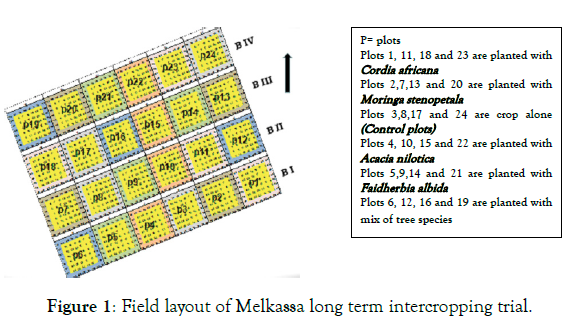
Figure 1: Field layout of Melkassa long term intercropping trial.
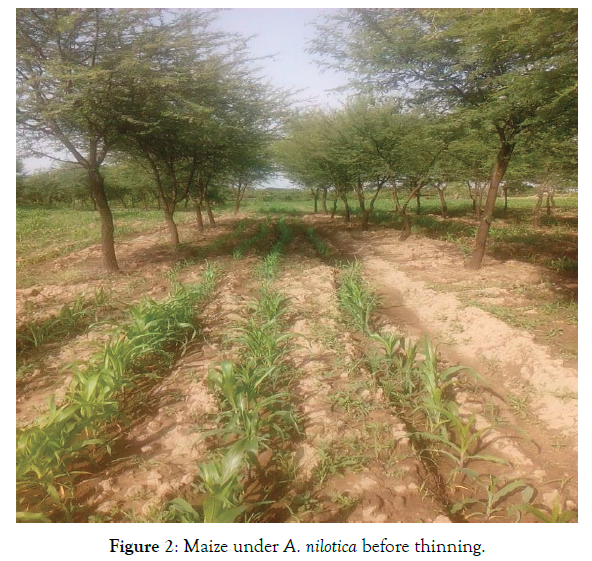
Figure 2: Maize under A. nilotica before thinning.
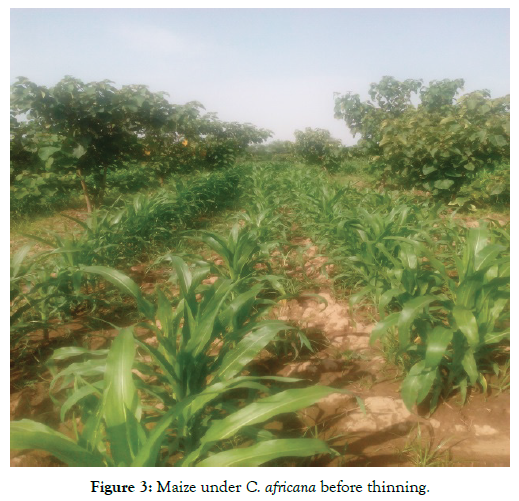
Figure 3: Maize under C. africana before thinning.
Description of tree species
Cordia africana Lam. (Syn: Cordia abyssinica, Cordia harara, Cordia holstii) (Boraginaceae): Small to medium sized tree, up to 10 m tall (18 m or more in forests). This is one of the most important timber trees in Ethiopia. The wood is easy to work on, and is used for making drums, beehives, household furniture and containers, and many other items. It polishes well and does not crack easily as long as the wood is seasoned before it is processed. Cordia africana is also important forage plant for both domestic animals and bees (NDA, 2011).
Moringa stenopetala (Bak. f.) Cuf. (Syn: Donaldsonia stenopetala, Moringa peregrine) (Moringaceae): Tree 6-10 m tall, known only from North Kenya and Southwest Ethiopia. The fresh leaves are cooked and eaten. The roots are used for treating malaria. Extracts of the plant were found to lower blood glucose concentration (NDA, 2011).
Acacia nilotica (Fabaceae): Tree up to 2.5-14 m high. Stipular spines up to 8 cm long, straight or almost so, often deflexed. There are five subspecies of this plant including Subsp. nilotica, indica. Subulata, kraussiana and leiocarpa in different parts of Ethiopia, Kenya and Tanzania. The bark and fruit pulp of Acacia nilotica are reported to be edible in Southern and South-eastern parts of Ethiopia. The pods are also eaten in times of food shortage (Ethiopia and Kenya). The inner bark and thick fruit pulp are boiled in water, sugar added and then drunk as tea in the Maasai of Kenya and Tanzania. The wood is termite resistant. It is used for timber, poles, fuel wood, charcoal, pestles, tool handles, toothbrushes (tooth sticks) and carvings. The bark is used against dysentery and haemorrhoids, and as a febrifuge, lactogenic and leucorrhoea. Root and leaf extracts are used to treat chest pain, abdominal pain, tuberculosis, cough and many other respiratory diseases (NDA, 2011).
Faidherbia albida (Formerly Acacia albida Del.) (Syn: Faidherbia albida) (Fabaceae): Tree up to 30 m high with wide rounded crown when mature, sometimes deciduous, stipular spines straight, up to 2 cm long.
Habitat: woodland and grassland, on seasonally waterlogged ground, often leafless during the rainy season; up to 2600 m altitude. Found in most Ethiopian regions, widespread in tropical and Subtropical Africa, also in West Asia. A very important species in traditional agro forestry systems. In addition to the uses given for the genus, Faidherbia albida pods have been used as a soap substitute, bark extracts are used to treat toothache and the boiled seeds are edible. Seeds contain up to 27% protein. The pods which are also rich in protein are used for flavoring and eaten at the beginning of the rains when other food items are scarce. They may also be mixed with maize and ground nut meal for food. Pods, leaves and other parts are eaten by domestic and wild animals. Honeybees forage nectar and pollen from the flowers during July and December. Previously in Ethiopia, planks for making large secure doors were made from Faidherbia albida. The wood is less suitable for fuel but easy to work into any desirable household furniture. The old bark contains up to 28% tannin. In traditional medicine the bark, fruits and leaves are used against headaches, toothache, colds and stomach-aches. The bark is used as a febrifuge, against haemorrhage, coughing, pneumonia, kidney diseases, vomiting, diarrhea, postpartum complications, and psychological disorders and ophthalmic while various parts are used to treat influenza, heart tonic and rheumatism (NDA, 2011).
Tree growth and survival
Analysis results indicate that there is significant difference in survival and adaption of tree species tried out in the trial at a=0.05. Growth of trees planted also revealed marked differences between species and across the years. Accordingly Acacia nilotica revealed significantly higher survival percentage (90%) followed by Cordia africana (70%). These survival percentages however did not show significant differences across the years in 2018 (before thinning) and 2020 (after thinning) for Acacia nilotica and Cordia africana. Mixed tree species showed moderate survival percentages (40-50%). The survival of trees in mixed trees significantly declined as the years went by (Figure 4). The survival of Moringa stenopetala declined significantly across the years. Faidhrbia albida resulted in the lowest tree survival percentage (15%) in 2017 that is statistically comparable to that of Moringa stenopetala (Figure 4).
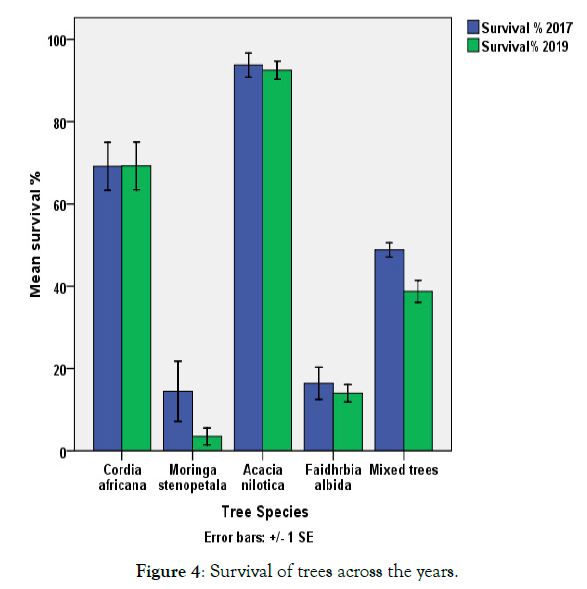
Figure 4: Survival of trees across the years.
The growth of highly surviving and fully stocked tree species i.e. Acacia nilotica and Cordia africana were not markedly different before thinning (Figure 5A) Analysis of tree growth data after thinning in 2019 indicated that Acacia nilotica had a significantly higher growth (a=0.05) in height, DBH (diameter at breast height) and RCD (root collar diameter) with 6 m,12.6 cm and 16 cm respectively as compared to the remaining tree species and tree mixes at six years after planting (Figure 5B). Tree growth under mixed tree plots was second in performance. Faidhrbia albida revealed the least growth in height, DBH and RCD.
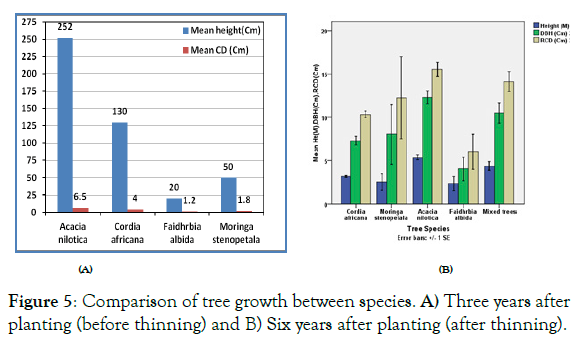
Figure 5: Comparison of tree growth between species. A) Three years after planting (before thinning) and B) Six years after planting (after thinning).
Grain yield
Analysis results of 2018 yield data under plots of different treatment conditions revealed that yield of maize under un-thinned Acacia nilotica was significantly lower compared to the yield under un-thinned Cordia africana and crop alone plots (a<0.05). Maize yields in 2018 from un-thinned Cordia africana and crop alone plots were found higher and their difference was found statistically non-significant.
A significantly higher yield (a<0.05) of maize was observedunder plots of thinned Cordia africana compared toAcacia nilotica in 2020. However maize yield from crop alone plots was found higher but statistically comparable with the yield from thinned Cordia africana plots in 2020. Maize yield under thinned Acacia nilotica was found out to be the least in 2020 (Figure 6).
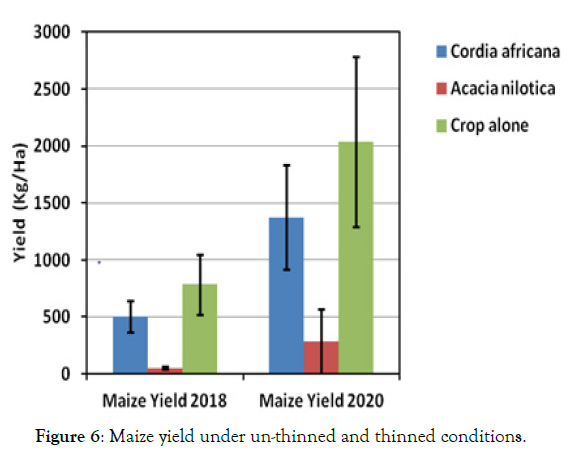
Figure 6: Maize yield under un-thinned and thinned conditions.
The data analysis showed that maize grain yield was significantly (a=0.05) affected by both of the examined factors, i.e., thinning and tree species. Thinning Cordia africana has significantly influenced maize intercropped yield in 2020 accompanied by 36.4% increase in grain yield. Maize yield was found out to be significantly higher (a=0.05) under thinned plots of Cordia africana in 2020 as compared to un-thinned plots in 2018. Thinning Acacia nilotica resulted in no significant difference with the yield of maize. Maize yield from crop alone plots in 2020 was significantly higher than the crop yield in 2018.
Maize above ground biomass
Analysis results of 2018 biomass data under plots of different treatment conditions revealed that above ground biomass of maize under un-thinned Acacia nilotica was significantly lower (a=0.05) compared to the biomass under Cordia africana and crop alone plots in the same year. Maize biomass in 2018 from un-thinned Cordia africana and crop alone plots were found higher but their difference was found statistically non-significant.
A significantly higher (a=0.05) maize biomass was observedunder crop alone plots as compared toAcacia nilotica in 2020. However maize biomass from crop alone plots were found statistically comparable with the biomass from thinned Cordia africana plots in 2020. Maize biomass under thinned Acacia nilotica was found out to be the least in 2020 (Figure 7).
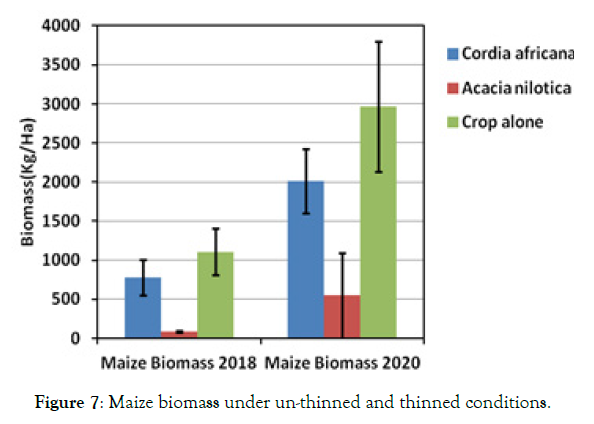
Figure 7: Maize biomass under un-thinned and thinned conditions.
Thinning Cordia africana has significantly influenced maize biomass in 2020. Maize biomass was found out to be significantly higher (a=0.05) under thinned plots of Cordia africana in 2020 as compared to un-thinned plots in 2018. Thinning Acacia nilotica in 2020 resulted in no significant difference with the biomass of maize. Maize biomass from crop alone plots in 2020 was significantly higher than maize biomass in 2018 (Figure 7).
Harvest Index (HI)
Harvest index is the physiological efficiency of a plant for changing the total dry matter into economic yield. It is the ability of the plant to effectively utilize environmental resources like moisture, light, nutrients, and growing space. This would result in high photosynthesis activity and higher allocation of photosynthate into grain yield. Harvest index is the ratio of grain yield to total above ground dry biomass yield multiplied by 100. Harvest index of maize under un-thinned and sole crop plots did not reveal significant differences in 2018. In contrast the harvest index of maize under un-thinned Acacia nilotica (53%) declined significantly (a<0.05) to 13% under thinned conditions (Figure 8). This might be attributed to the significantly lower maize yield (282 kg/ha) that was attained after thinning of Acacia nilotica. This indicates that Acacia nilotica is not a good match to maze in tree- maize intercropping system and even the thinning management given to it could not facilitate positive interaction that could be explained by complementarities in the system and increase in grain and biomass yield of maize.
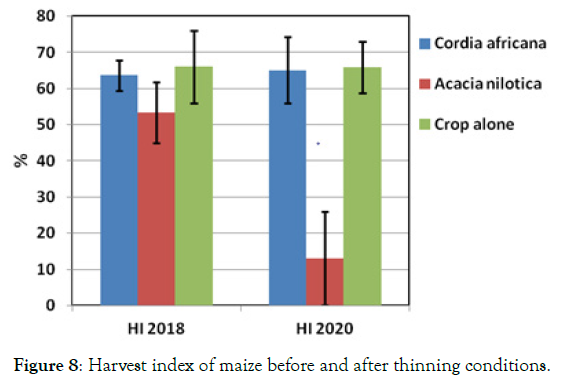
Figure 8: Harvest index of maize before and after thinning conditions.
The harvest index of maize under un-thinned Acacia nilotica was found statistically non-significant with that of Cordia africana and sole crops. This is because it resulted from division of the grain yield to a comparatively very low maize biomass (87.7 Kg/ha) under Acacia nilotica in 2018. The harvest indices of maize under Cordia africana and sole crop conditions were found to have no significant differences both under thinned and un-thinned conditions.
Matching of trees with the right crops brings complementarities in tree intercropping systems with no significant reduction in intercropped yield as compared to crop alone (control) conditions. Trees incorporated into crop fields and agricultural landscapes contribute to increased nutrient availability to crops through nitrogen fixation and enhanced nutrient cycling [4]. In this study thinning Cordia africana has resulted in a significant increase in maize biomass and grain yield that are expressions of complementarities in tree intercropping system. Stoking Cordia africana at 25% thinning intensity (392 trees/Ha) brought a significant increase in maize biomass and grain yield without causing any significant yield reduction as compared to crop alone (control) plots. This finding agrees with Bertomeu M [6] who explained that agroforestry systems with trees planted at wide spacing will result in higher crop yields, because of reduced tree-crop competition, reduced tree establishment and management costs and in larger tree diameter growth. Santos-Martin and Van Noordwijk [14], Bertomeu M [6] also concluded that maize yield is considerably influenced by tree density: a density of 800 trees ha-1 results in only 1/3 of the total yield that could be harvested on a maize monoculture scenario whereas a density of 100 trees ha-1 still provides close to 90% of the monoculture crop yield. This would agree with the finding of this study that thinning Cordia africana positively influences tree intercropping systems and increases maize yield and biomass to a level comparable with the yield from crop alone systems while diversifying products (a peculiarity of agroforestry systems) from the same unit of land. Yield of maize under un-thinned Cordia africana was 63.9% of the total yield that could be harvested on maize monoculture while thinned Cordia africana with removal of 130 trees ha-1 resulted in close to 67.5% of the crop alone (control plot) yield. Compared to monocropping, tree-intercropping systems provide, in addition to the tree product, several other farm and environmental benefits: better protection against soil erosion, improved soil health and more efficient nutrient cycling, climate change mitigation and biodiversity conservation and better insect and pest control [17,9,16,6].
Thinning Acacia nilotica improved growth and performance of the species. Maize biomass and grain yield under thinned Acacia nilotica was found significantly lower than the yield under thinned Cordia africana and monocropping (Control) plots. Maize biomass and grain yield under Acacia nilotica before thinning was also significantly lower than the yield under un thinned Cordia africana and monocropping (control) plots. This could evidence that the interaction between Acacia nilotica and the associated maize crop was not a complementary type and the provision of thinning management could not influence it positively. Phenotypically Acacia nilotica has extensive branches and dense canopy that could causes attenuation of photo synthetically active radiation that is highly demanded by a C-4 plant like maize in the understory. This could result in retarded growth of maize and decline in biomass and grain yield. Pandey CB, et al. [11], Bargali SS, et al. [2], Bargali K and Bargali SS [3] reported that Acacia nilotica generally reduced crop yield under its canopy and this reduction varies with distance from the tree trunk [12] further disclosed that reduction in grain yield was maximum (30%) under the large tree canopy and lowest (12%) under the small tree canopy due to decreased availability of light by 44 to 62% under the canopy that resulted in slow photosynthetic rates and growth. El-Khawas SA and Shehata MM [7], Bargali K and Bargali SS [3] also reported that the leaf leachates of Acacia nilotica inhibited the germination and growth of Zea mays. Velu G, et al [18], Bargali and Bargali SS [3] related that the inhibitory effect of Acacia nilotica on seed germination and seedling growth is due to the presence of allelochemicals including tannins, flavonoids and phenolic acids.
Recommendations on tree stocking and appropriate tree - crop matching are central in tree intercropping systems to enhance complementarities and increase crop biomass and yield. The results of this study indicated that tree species and stocking influence biomass and crop yield of maize in tree intercropping systems. Thinning of Cordia africana influenced tree intercropping systems positively and increased maize yield and biomass to a level comparable to the yield from crop alone systems. Yield of maize under un thinned Cordia africana plot was 63.9% of the total yield that could be harvested on maize monoculture while the same plot with thinned Cordia africana (removal of 130 trees ha-1) resulted in close to 67.5% of the crop alone yield. Therefore it is justifiable to conclude that with the mentioned stocking Cordia africana is ideal for a tree- maize system that can produce maize yield comparable to maize monocropping while providing additional woody products that the farmer may not get from practicing pure monocropping. Maize biomass and grain yield under thinned Acacia nilotica was found significantly lower than the yield under thinned Cordia africana and monocropping (Control) plots. Maize yield under crop alone plot was significantly higher than the same under thinned Acacia nilotica. Maize biomass and grain yield under un thinned Acacia nilotica was also significantly lower than the yield under un thinned Cordia africana and monocropping (control) plots. Considerable reduction in grain yield and biomass observed under the canopies of Acacia nilotica both before and after thinning would lead us to conclude that the species is in compatible to tree maize systems. Further studies may need to be carried out to distinguish the effects of site on crop performance from those resulting from the associated trees.
I thank ACIAR (Australian Centre for International Agricultural Research) for funding long term monitoring of tree- crop interaction study in Ethiopia. This activity was an extension superimposed on the already established site for long term monitoring of tree- crop interaction. I thank Dr. Abyneh Derero for preparing the layout for tree thinning.
Citation: Gebretsadik W (2021) Tree Stocking Influences Maize Biomass and Grain Yield Under Tree Intercropping Systems in Semi-arid Ethiopia. J Forest Res. 10:294.
Received: 02-Nov-2021 Accepted: 23-Nov-2021 Published: 30-Nov-2021 , DOI: 10.35248/2168-9776.21.10.294
Copyright: © 2021 Gebretsadik W. This is an open-access article distributed under the terms of the Creative Commons Attribution License, which permits unrestricted use, distribution, and reproduction in any medium, provided the original author and source are credited.